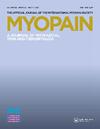The Effectiveness of Portable Audio Biofeedback Device in Myofascial Pain Syndrome in Neck and Upper Trapezius Muscles
引用次数: 6
Abstract
Abstract Objective: The aim of this study was to investigate the effectiveness of a portable audio biofeedback device in the treatment of myofascial pain syndrome [MPS]. Methods: Patients referred to the clinic with MPS involving the upper neck and trapezius who were were randomly assigned into two groups. Group 1 was to use a portable audio biofeedback device for 30 min twice a day in addition to completing a home based exercise program. Group 2 received only the home-based exercise program. The home-based exercise program was comprised of neck isometric-isotonic, back extensor stretching and posture exercises five times a week, performing each exercise once a day with 15 repetitions for 4 weeks. Measurements were taken before and after the treatment. The severity of the pain was measured by visual analog scale. The number of trigger points, pressure pain threshold, cervical joint range of motion and head-shoulder angles were also recorded. Disability was assessed by the Neck Pain Disability Scale. Results: About 90 patients with MPS were recruited and 60 patients [45 females, 15 males, 30 patients per treatment group] completed the study. All parameters were improved in both groups [p < 0.05] except cervical range of motion values [p > 0.05] after the treatment. In Group 1, more improvements were detected in head angles compared to Group 2 and the differences were statistically significant [p = 0.017]. There were statistically significant differences between the groups in head angles, while no significant differences were detected in the visual analog scale, number of trigger points, pressure pain threshold, cervical range of motion, shoulder angle or Neck Pain Disability Scale scores [p > 0.05] after the treatment. Conclusion: Exercise therapy seems to be effective in the treatment of MPS; however, portable audio biofeedback treatment does not provide any additive effect except correcting head angle in the treatment of MPS.便携式音频生物反馈装置治疗颈、上斜方肌肌筋膜疼痛综合征的疗效
摘要目的:本研究旨在探讨便携式音频生物反馈装置治疗肌筋膜疼痛综合征的有效性。方法:临床就诊的MPS累及上颈部及斜方肌患者随机分为两组。第一组在完成家庭锻炼计划的基础上,每天两次使用便携式音频生物反馈设备30分钟。第二组只接受以家庭为基础的锻炼计划。这项以家庭为基础的锻炼计划包括颈部等长等张力、背部伸肌拉伸和姿势锻炼,每周5次,每次锻炼每天一次,重复15次,持续4周。治疗前后分别进行测量。采用视觉模拟量表测定疼痛程度。同时记录触发点数量、压痛阈值、颈椎关节活动范围和头肩角度。通过颈部疼痛残疾量表评估残疾程度。结果:共招募约90例MPS患者,共60例患者(女性45例,男性15例,每个治疗组30例)完成研究。两组治疗后各项指标均有改善[p 0.05]。第1组患者的头部角度较第2组有明显改善,差异有统计学意义[p = 0.017]。治疗后两组患者的头部角度差异有统计学意义,而视觉模拟量表、触发点个数、压痛阈值、颈椎活动度、肩关节角度、颈痛失能量表评分差异无统计学意义[p > 0.05]。结论:运动疗法是治疗MPS的有效方法;然而,便携式音频生物反馈治疗除了在MPS治疗中校正头部角度外,没有提供任何附加效应。
本文章由计算机程序翻译,如有差异,请以英文原文为准。
求助全文
约1分钟内获得全文
求助全文

 求助内容:
求助内容: 应助结果提醒方式:
应助结果提醒方式:


